
Argent, on a bend engrailed sable a wagon of the first[and a mullet for difference(?)]--BINNING, Scotland.Wake's Knot. See Cords.
Quarterly gules and or, four lions passant gardant counterchanged--SOUTH WALES.Wall, (sometimes called a dyke, fr. mur): this is generally found named in connection with castles or towns which are walled(muraillé). A wall of this kind should be masoned(fr. maçonné) and embattled(fr. crenellé), even though this be not specified.
Argent, three lions passant gardant in pale gules, their tails passed between their hind legs and reflected over their backs--NORTH WALES[MS. Harl. 4199].
Argent, a tower flanked by a wall and two turrets gules--DAMAN.Wallet. See Palmer's Scrip and Purse.
Gules, a tower embattled with a round roof between two other turrets standing on a wall extended in fesse, arched inarched ... --BRIDGMORE.
.... On a mount rising out of water a castle with three towers embattled and domed and joined to each other by a circular wall ... --Seal of the town of BOSNEY, Cornwall.
Or, a dyke[or wall] fesswise[masoned proper] broken down in some places gules; on a chief sable three escallops of the first; in base a rose as the second--GRAHAM, Inchbrakie, Scotland[similar arms borne by GRÆME of Stapleton].
Sable, three walnut leaves or between two bendlets argent--WALLER, co. Berks.Wand. See Willow.
Argent, on a bend gules three walnut leaves of the first--UVEREY.
Argent, a chevron between three walnut leaves[otherwise oak leaves] vert--TUYSTALE.
 |
| BUBBLEWARD. |
Argent, three demi-lions gules issuant out of water proper--MULLIKEN, Scotland.
Azure, in base water vert, thereon a bridge of three arches argent; on the centre a turret of the last flagged gules--VINICOMBE.
Argent, a field and river proper, on the field a buck gules drinking in the river--BARNEVELT.
Argent, a cross moline azure placed in a loch proper[?], and in chief two mullets of the second--MILLER, Gourlebank, Scotland.
D'azur, à la rivière d'argent posée en fasce et chargée d'un bateau de même--BOUDET, Auvergne.
Per fesse gules and water proper, a fesse arched with three towers or, all masoned sable[otherwise, Gules, on a fesse arched three towers or, all masoned sable]; in chief a fleur-de-lis between two roses of the second argent seeded gold; in base three ships with one mast and yard, each sable, two and one[otherwise, in base a river proper, thereon three vessels each with one mast and yardarm of the third]--Town of CAMBRIDGE.
Or, in a pond(?) vert[otherwise, however, Or, on ground vert] a boar passant sable--OHENLOYNE[known as Hibernicus SYLVESTRIS].
A tree, from the root whereof runs a spring of water; on the sinister thereof stands a stork picking up a fish, on the dexter is another bird resembling a Cornish chough--City of WELLS, co. Somerset[see also another under Wells].
Per fesse, each piece argent; within its base barry wavy argent and azure three ducks swimming, their bills in the water or, waves of the second; over all on a fesse engrailed gules as many roses silver--REVERS. [From Glover's Ordinary.]
Azure, three water-bubbles proper--AIRE.
Argent, two bubbles and a third rising out of water in base--BUBBLEWARD. [From Berry's Encyclopœdia.]
 |
| Eearly forms of water-bougets. |
 |
| Later forms of water bougets. |
William de ROOS, de goules, a trois bouges d'argent[in other copies, 'd'azur a trez buz d'or,' and 'trois bousses d'or']--Roll, temp. HEN. III.
Robert de ROOS, de goules, a treis buz d'argent[in another copy, a trois buzes d'argent]--Ibid.
Sire Johan de ROS, de goules, a iij bouces de sable--Roll, temp. ED. II.
Sire Robert de ROS, de goules a iij bouces de ermyne--Ibid.
Guillemes de ROS assemblans I fu rouge o trois bouz blans.
Roll of Carlaverock.
Monsire TRUSBUTT[elsewhere R. TRUSSEBUZ], d'argent, a une daunsy sable entre trois bouges sable[elsewhere blazoned 'tres boutz,' a play on the name]--Roll, temp. ED. III.
Monsire de BINGHAM, port d'or, sur fes gules trois boustes d'argent--Ibid.
Monsire de SAUNSCHEVERELL, port d'argent, une salter d'asur, au busteaux d'or en le salter--Ibid.
Gules, a water-bouget argent--DELAMORE.
Or, on two bars gules three water-bougets argent--WILLOUGHBY, co. Derby.
Argent, a bend between two water-bougets sable--LOCKEY, Essex. co. Hereford; HOMES, co. Hertford; and co. York.
 |
| Dossers. |
Sable, two dossers suspended by an annulet argent; on a chief gules three fleurs-de-lis or--BANESTER, Darwyn, co. Lancaster.Finally, it will be seen that the same figures in the same coat of arms are blazoned as buckets(q.v.), and this is possibly the modern form of the ancient 'bougets.'
Argent, two buckets suspended by an annulet saltirewise sable between three fleurs-de-lis gules--BANISTER.
Quarterly; first and fourth three bendlets ermine; second and third gules, five water-cress leaves in saltire argent--GUEVERA, Lincoln. [Granted or allowed 1617.]Water-leaves. See Leaves.
Argent, a fesse gules; in the dexter chief point a weasel passant proper--BELET.Weathercock. See Vane.
Gules, three weasels courant argent--SCHOPPIN.
Sable, a chevron ermine between three weasels passant argent--BYRTWYSELL, Amcote Hall, co. Lancaster.
Argent, a foine[? marten] sable, on a chief indented gules three escallops or--MARTEN, Sussex.
Or, on a chief vert an ermine passant proper--WATSON, Newport, Salop.
De gueules, à une hermine au naturel, passante, accolée d'un manteau d'hermine, doublé de toile d'or voletant--Ville de VANNES, Bretagne.
De gueules, à une grille d'or, supportant une hermine passante d'argent--Ville de S.MALO.
Azure, on a chevron argent between three leopard's heads or, each having in the mouth a shuttle of the last, as many roses gules seeded of the third barbed vert--WEAVERS' COMPANY OF LONDON; Inc. temp. Hen. I., arms granted 1487.
Per saltire azure and gules, in fesse two shuttles filled paleways or; in chief a teazel; in base a pair of shears lying fessways argent; on a chief ermine a slea between two burling-irons of the third--Company of WEAVERS, Exeter.
 |
| TREFUSIS. |
Argent, a chevron between three wharrow spindles sable--TREFUSIS, Cornwall.
Argent, three spindles in fesse threaded or--BADLAND.
Argent, three fusils upon slippers gules--HOBY, Neath Abbey, co. Glamorgan; HOBBY, co. Berks.
Argent, a chevron between three spindles of silk sable--DARDAS.
Azure, three spindles of silk or; a canton ermine--BISHOPTON.
 |
| Weaver's shuttle. |
 |
| SHUTTLEWORTH. |
Azure, on a fesse argent between two bees volant in chief proper and in base a wolf's head couped or, a wheel-shuttle in fesse, also proper--MILLER, Preston, co. Lancaster; granted 1821.
Or, fretty azure; on a chief of the last a bee volant between two shuttles in pale of the first--HORROCKS, co. Lancaster.
Argent, three weaver's shuttles sable, tipped and furnished with quills of yarn, the threads pendent or--SHUTTLEWORTH, co. Lancashire and Yorkshire; also by SHUTTLEWORTH, Bp. of Chichester, 1840-42.
Argent, three weaver's shuttles in fesse sable--SHAKERLEY.
Azure, three shuttles or, quills argent--PEIRSON.
 |
| Weaver's slay. |
 |
| Weaver's shears. |
Azure, a chevron between in chief two swans, and in base a pair of shears argent--DELANEY; also LANNOY, Hammersmith.The teazel has been already noticed under Thistle, and it is adopted by the CLOTH-WORKERS' as well as by the Exeter WEAVERS' Company.
 |
| PROCTOR. |
Or, three wedges[? nails] sable--PROCTOR, Norfolk.
Vert, three wedges[? nails] argent--ISHAM, Northumberland.
Argent, on a chevron between three wedges sable five mullets of the first--WADGE, Upton, Lewanneck.
Argent, a chevron between three wedges[or piles] sable--PEGGE, Beauchief Abbey.
Argent, a chevron between three stone-bills sable--BILLESBY.
 |
| Weel. |
 |
| Fish-basket. |
Or, a chevron between two fish-baskets[weels or eel-pots]--FOLEBARNE.
Argent, a chevron ermine between three fish-baskets, hoops outwards vert--WYLLEY, 1716.
Per bend gules and azure, a fish-basket weel, or eel-pot in bend or; on a chief azure a wolf's head erased sable between two ogresses--WHEELER, co. Worcester.
Gyronny of eight, gules and or, a fish-weel in fesse sable--FORTON.
Argent, on a chevron sable between three flasks or jars[they are weels] proper five ermine spots of the first--WILLARD, Eastbourne, Sussex.
A weir-basket filled with fish--Seal of William WEARE, of Weare Gifford, Devonshire.
An eel-pot per pale argent and vert--The Badge of Lord WILLIAMS of Thame(now borne by the Earl of Abingdon).
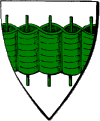 |
| ZORVIS. |
Argent, a weir vert--ZORVIS of that Ilk, Scotland.Welk. See Whelk.
A wivern with wings endorsed gules, standing on a fish-weir devouring a chief and pierced through the neck with an arrow--Crest of family of VENABLES, Kinderton, Cheshire.
 |
| Well. |
Gules, three wells argent, masoned sable--HADISWELL.Wervels, or Varvells. See under Falcon.
Azure, a fesse between three wells argent--HODSALL.
Azure, a fesse wavy between three stone fountains argent--HODSOLL, London and Kent.
Gules, three square wells argent, water azure--HODISWELL.
Sable, three round wells argent--BOXTON.
Argent, out of a well gules an oak-tree vert--WELLWOOD, co. Fife.
Vert, a heron argent drinking from a well tenne--Arms ascribed to St.Hugh, Bishop of Lincoln, 1186-1200.
Per fesse argent and vert, a tree proper issuing from the fesse line; in base three wells two and one masoned--A variation of the insignia of the City of WELLS, co. Somerset.
Per pale azure and sable, a hart's head couped or, and in chief three cold[?] wells proper--CALDWELL, Glasgow.
Gules, three wells[or water-houses] argent, the doors sable; the water undy of six argent and azure--Old arms of WATERHOUSE, Conisborough, co. York.
 |
| Whale's head erased. |
 |
| WHALLEY ABBEY. |
Gules, three whales haurient or, in the mouth of each a crosier[otherwise vorant as many crosiers] of the last--WHALLEY ABBEY, co. Lancaster[founded 1309].Wharrow. See Weaver's.
Ermine, on a bend sable three whale's heads erased or--WHALLEY.
Argent, three whale's heads erased and erect or--WHALLEY.
Or, two bars wavy, and in chief three whale's heads erect and erased sable--COLBECK, co. Bedford.
Per pale azure and purpure, three whale's heads erased or, each ingulphant of a spear-head argent--Sir Hugh VAUGHAN, Littleton, Middlesex[temp. HEN. VIII.]
 |
| Ear of Wheat. |
Azure, a wheatsheaf between three thistles or, all within a bordure of the last--BAIN, Berwick.Barley is specified in some cases as in the insignia of the BREWERS of London and Exeter; the garbs are sometimes blazoned as barley garbs, but they are not distinguishable from others. (See Tun.)
Gules, two garbs in saltire or, banded azure--SERJEANTS' INN, Fleetstreet.
Gules, three garbs in bend or, within two bendlets argent and between two lozenges vair--RICKARDS, Westminster.
Vert, a garb banded, and bowed in the head proper--BOWER.
Sable, five garbs in cross or--MEREFIELD, London.
Gules fretty or, on a canton azure two ears of wheat slipped without blades of the second--WHYSHAW, Lees, co. Chester.
Argent, on a fesse gules between six martlets sable three ears of wheat stalked and leaved or--GILLIOT.
Ermine, on three bars humetty sable fifteen wheat ears or, five and five--STOKES.
Sable, two bars ermine between fifteen wheat ears or, five, five and five, a bordure of the second--STOKES.
Per bend sinister azure and argent; on the dexter side three ears of wheat on one stalk or; and on the sinister side three fleurs-de-lis one and two of the first--SOLTAU, co. Devon.
Gules, a chevron between nine ears of wheat tied in three parcels or--JOHN WHEATHAMSTEAD, Abbot of S.Albans, ob. 1464.
Azure, a chevron argent between three ears of corn as the second slipped and bladed or--Thomas EYRE, co. Buckingham, granted 1476.
Ermine; on a chief vert three wheat-sheaves[i.e. garbs] argent--PROSSER.
Vert, on a fesse between three bundles of wheat(or barley), each consisting of as many stalks, one erect and two in saltire or, a greyhound courant argent pied proper--MATCHAM.
D'azur, au fer de moulin d'argent, accosté de deux epis de blé d'or, les tiges passées en sautoir vers la pointe de l'ecu--JACOBE DE NAUROIS, Champagne.
Azure, three ears of guinea-wheat couped and bladed or, two and one--GRAUNDORGE, Donington, co. Lincoln.
Azure, two ears of big-wheat in fesse, stalked and bladed or--Ralph BIGLAND[afterwards] Garter, to whom they were granted 1760.
Ermine, a lion rampant gules, on a chief azure an ear of big-wheat couped and bladed or, between two estoiles argent--BIGNELL, Salisbury.
Gules, three cups or, in the middle fesspoint as many ears of barley, two in saltire and one in pale of the last--GOODALLE, Scotland.Mention is made of oats(fr. avoine) at an early date, when the term aveye is used(see under Garb), and one or two instances occur in later coats of arms. Heraldic writers say the term rizom should be applied to the ears of oats.
Quarterly, 1 and 4; azure, a dolphin embowed between three ears of barley or, a bordure engrailed of the second; 2 and 3, argent, three eel spears, tynes upwards sable; on a chief azure a lion passant gardant or--John FISHER, Bp. of Rochester, 1504.
Gules, on a chevron argent between three handsfull of barley ears(each containing five) or three bees proper--SMITH, Yarmouth, Norfolk, granted 1722.
Sire .... de BEUMEYS, de azure, a les garbes de aveye de or--Roll, temp. ED. II.
Azure, three oat-sheaves or--BENNIS, Clare, Ireland.
Argent, on a bend azure three oat-sheaves or--OTTLEY, co. Salop.
Quarterly, first and fourth; argent, on a bend azure three oat-sheaves or, second and third argent, an eagle displayed sable--Adam OTLEY, Bp. of St.David's, 1713-23.
 |
| Rye. |
Gules, on a bend argent three rye-stalks sable--RYE, Suffolk, 1716.
Argent, a chevron gules between three ears of rye proper, slipped and bladed vert--RIDALE[or RIDELL] Scotland; Baronetcy. 1628.
Argent, a fesse between three rye-sheaves azure--RIDDELL, co. Northumberland.
Argent, five stalks or rye growing out of the ground in base vert--AHRENDS.
 |
| BELVOIR. |
Azure, a Katherine-wheel or--BELVOIR, co. Lincoln; also WYTHERTON.Other wheels are found named, i.e. the Cart-wheel, usually of eight spokes. In one case the Water-wheel is named, and for Mill-wheels see under Mill.
Azure, a Katherine-wheel between two columns or; in chief a regal crown proper; in base an axe argent, handled of the second, lying fessways, the blades downwards[S.Katherine with her wheel is the crest of the same Company]--TURNERS' COMPANY, [Inc. 1604].
Gules, a Katherine-wheel or--S.KATHERINE'S HALL, Cambridge, [founded 1475].
Per fesse gules and azure; in chief a sword barwise argent, hilt and pomel to the dexter side or; in base a demi-Katherine-wheel of the last divided fessways, the circular part towards the chief--S.KATHERINE'S HOSPITAL, London.
Azure, a Katherine-wheel with a Cross Calvary projecting from it in chief argent--Augustinian Nunnery, FLIXTON, Suffolk.
Azure, two bars or, in chief a Katherine-wheel between as many buglehorns argent--MERTINS, Lord Mayor of London.
Gules, three bars argent, on a chief azure three Katherine-wheels or--LEPTON, co. York.
Argent, on a chief azure two Katherine-wheels of the first--WHEELER, co. Salop.
Azure, a sword argent, between three Katherine-wheels or--BAYLE.
D'azur, à trois roues de Sainte Catherine d'or--CATHERINE, Bourgoyne.
 |
| MARTEJOYS. |
Gules, a wheel of eight spokes or--MARTEJOYS.Wheel shuttles. See Weaver's.
Gules, a fesse between three cart-wheels or--CARRINGTON, co. York.
Gules, a chevron between three wheels or; on a chief argent an axe lying fessways proper--WHEELWRIGHTS' Company, [Inc. 1670].
Azure, a horse argent, bridled gules, between three wheels or--MORCRAFT.
Or, a camel statant sable, between three half-wheels azure; on a chief of the third a wheel argent enclosed by two bezants--John WHEELER, Stoke, Surrey, 1543. [From Glover's Ordinary.]
Argent, a wheel or, vert between the spokes--LLES AP COEL.
Azure, a wheel of a watermill or; on a canton of augmentation the royal badge of England and Scotland, viz. the rose and thistle conjoined palewise proper--DE MOLINE, Ambassador from the Doge of Venice, temp. King James.
 |
| Whelk. |
Argent, a chevron gules between three whelks sable--SHELLEY, co. Lincoln.Whip: this has been observed only in one case.
Sable, a fesse engrailed between three whelk-shells or--Sir John SHELLEY, co. Sussex.
Sable, on a fesse engrailed or between three whelks argent, as many maiden's heads proper crined of the second--SHELLEY.
Gules, a chevron[otherwise a fesse] vair between three whelk-shells or--WILKINSON, co. Durham; granted 1538.
Gules, on a chevron between three whelks argent as many demi-lions rampant sable--WILKINS, Kent.
Sable, on a fesse argent three whelks lying fessways gules--JOCE.
Gules, three whips of three lashes, each argent--SWIFT, Scotland.Whirlpool. See Gurges.
 |
| Lord HAWKE. |
Argent, an anchor pendent azure, the ring and timber[i.e. crosspiece] or; on a chief of the second a boatswain's whistle and chain of the third, the chain supporting the anchor--MASTERS' and MARINERS' Company, Newcastle-on-Tyne.White. See Colour; also Argent.
Argent, a chevron erminois between three boatswain's whistles azure--HAWKE, co. York; Barony, 1776.
Argent, a willow-tree vert--BENNISON.Wimble. See Auger.
Argent, six osier wands(or bastons) interlaced in saltirewise in true love(sometimes in cross) proper, [i.e. sable]--Walter SKIRLAWE, Bishop of Lichfield, 1386; Bath, 1386; Durham, 1388-1406.
Argent, a chevron gules between three willow-trees proper--WILLIS, Dean of Worcester, ob. 1596.
Or, a salix proper[quarterly with the arms of Fane, &c.]--Count DE SALIS.
Argent, five palets couped at the top, wrapped with osiers in fesse gules, fretty in base with a serpent vert; in chief three roses--ANGUISH.
Argent, four wands[otherwise bendlets] interlaced in saltire azure between four eagles displayed ... --Seal of R. D. HAMPDEN, Bishop of Hereford, 1847-68.
Or, on a mount vert a windmill sable--SAMPSON.Windows: mentioned incidentally under Castle, Church, &c.
Per pale sable and azure, a windmill or--Walter LEPULL, co. Dorset.
Azure, a chevron or between three windmill-sails crosswise argent--MILNES, Scotland.
Argent, four windmill-sails conjoined in saltire sable--BAXTER.
 |
| Wine-piercer. |
Argent, a chevron azure between three frets[or wine-piercers] of the second, screws or--BUTLER, co. Sussex.Wine-press: this has been observed but in one instance.
Argent, a chevron engrailed[azure] between three frets[otherwise wine-piercers] or, the handles sable, banded gold--BOTELLER[Harl. MS. 1404].
Argent, a chevron between three gimlets azure, the screws or--BUTELLER, Harl. MS. 1386.
Argent, on a chevron gules a fret[wine-broach or piercer] of the first--CLAPHAM.
Argent, a wine-press gules--ANHAULT.Winged bull. See under Pegasus.
 |
| A dexter wing. |
 |
| Wings conjoined, (fr.vol). |
 |
| Wings conjoined in lure. |
Gules, three[dexter] wings elevated argent--NEWPORT.Wings, too, are very often attached to animals, &c., and though eagle's wings are generally intended, the dragon's wing is sometimes distinctly named; for the mode of drawing see under Cockatrice, Griffin, &c. In the Evangelistic symbols the Lion and Bull are represented with wings, as well as the Angel and the Eagle.
Argent, three sinister wings gules--SEXTON.
Argent, a fesse between three sinister wings sable--DARBY, Walton, co. Leicester.
Azure, three bars argent, on a chief of the last as many pair of wings conjoined gules--FLEMING.
Argent, a stag trippant surmounted by a tree eradicated vert; on a chief azure two wings expanded and conjoined of the field--RENNY.
Gules, a pair of wings conjoined in lure[otherwise inverted and conjoined] or--SAINT-MAUR.
Argent, on a pale azure three pairs of wings conjoined in lure of the first--B. POTTER, Bp. of Carlisle, 1629-1642.
Gules, five marlion's wings in saltire argent--Sir Arthur PORTER of Newark(Guillim, 1612, p. 225).
D'azur, à la fasce d'or chargée d'un lion leopardé de gueules, accompagnée en pointe de deux vols d'or--PASSERAT DE SILANS, Bugey.
Argent, a wivern with wings endorsed gules between two flaunches of the last--DRAKE.But the wings play an important part in the description of birds. For them heralds have devised quite a system of nomenclature, though, as a matter of fact, it is to a very slight degree put in practice, the choice of terms being very arbitrary, and the mode of drawing, perhaps, more so.
Argent, a stag trippant with wings attached to the buttocks and hind legs proper, between the attires a rose or--JONES, co. Brecknock.
Paly of six or and azure, a fesse chequy argent and sable, on a canton gules a dragon's wing erect of the third, in base a sword proper, pomel and hilt gold, surmounting a silver key in saltire--CURTIS[Lord Mayor of London, 1796].
Argent, a fesse counter-compony or and azure between three roses gules; on a chief of the second as many lion's gambs fixed to dragon's sinister wings sable; all within a bordure gobony of the third and purpure--WHITTINGTON.
 |
| Expansed. |
Azure, six seagulls, three, two, and one argent, the dexter wing displayed, the sinister close--APILBY, co. Salop.
Argent, an eagle, wings expanded gules, standing on the trunk of a tree raguly vert--PORTER.
Gules, a swan, wings expanded argent--DALE, co. Northumberland.
Argent, a chevron between three ravens expansed sable--ROOKEBY.
Argent, a reremouse displayed sable--BAXTER, Scotland.
Sable, a cockatrice displayed argent, crested, membered, and wattled gules--BOGAN, co. Devon.
 |
| Disclosed. |
Vert, a parrot, wings disclosed, holding up the left foot or--ANTICK.Where the expression preying or trussing(fr. empiétant) is used, the bird should be represented with the wings overt inverted. See illustration of a hawk trussing under Falcon.
Gules, on a canton argent a bird, wings expanded[or overt] and inverted sable--HUTTON.
Argent, a chevron gules between three sea-pies rising overt inverted brown--TREVENOUR.
 |
| Rising. |
Quarterly ermine and azure, in the second and third quarters an eagle rising[otherwise volant] or--ADAMS.
Argent, a fesse humetty gules between three ravens rising sable--PEIRCE, London.
Or, three birds(probably lapwings) surgerant ... a bordure vert--Sir Rhys HEN, co. Caernarvon.
Gules, on a chief or two swallows rising overt proper--SPEED, London.
Quarterly gules and vert, a dove rising, wings overt inverted, between three round buckets or--BRAMSTON.
Quarterly ermine and azure; in the second quarter an eagle rising wings overt inverted; and in the third quarter another rising wings displayed or--Sir Adam de BERRY.
 |
| Endorsed. |
Argent, on a raven, wings endorsed proper between four cross crosslets fitchy, one, two and one, anther gules--CROSS.
Gules, on a fesse wavy, between three swans with wings endorsed argent, as many crosses patty sable, each charged with five bezants--LANE, London.
Sable, a chevron ermine between three pelicans with wings endorsed or--MEDDOWES.
 |
| Erect. |
Gules, four swans erect argent--ROOSE, co. Cornwall.Elevated perhaps means something between endorsed and erect.
Argent, on a chevron engrailed gules, between in chief two birds with wings erect and in base an anchor or, five bezants--BOASE, co. Cornwall.
Azure, a chevron between three mallards, wings elevated[otherwise swans rising] argent--WOLRICH, co. Suffolk.
Azure, a pelican, wings elevated or, vulning her breast gules, between three fleurs-de-lis of the second--KEMPTON, co. Cambridge.
 |
| Volant. |
Argent, a fesse azure between three birds volant gules--TREWINCAN.Last of all we have the wings Close(fr. plié), that is with the wings closed towards the bird. See examples under Eagle, Falcon, Goose, Barnacle-goose, Swan, Sea-fowl, Stork, Lapwing, Parrot, Kingfisher, &c., under several of which Illustrations will be found, as well as under Heathcock, Heron, Moorcock, Owl, Raven, &c.
Gules, an eagle volant recursant in bend, wings overt or--BEES.
Argent, a heron volant in fesse azure membered or--HERONDON.
Azure, a chevron argent between three martlets volant or--BYERS.
Azure, on a mount vert a square brazen pillar supported on the dexter by a lion rampant regardant, and on the sinister by a dragon segreant, both or; in chief, on the top of the pillar a bundle of wire tied and bound together of the last between a bezant on the dexter side and a plate on the sinister--SOCIETY OF MINERAL AND BATTERY WORKS, London; incorporated 1568.Wire-drawers' implements: these occur only in the insignia of the London Company of WIRE-DRAWERS.
 |
| Copper. |
 |
| Point. |
 |
| Drawing-iron. |
 |
| Ring. |
Azure, on a chevron or, between in chief two coppers of the second, and in base two points in saltire argent, a drawing-iron between two rings sable--Company of GOLD AND SILVER WIRE-DRAWERS.
 |
| Engrossing block. |
Two arms embowed, vested gules, cuffed argent, holding between the hands proper an engrossing block or--Crest of the above Company.Wisals. See Turnip.
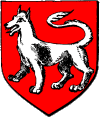 |
| LOWE. |
Gules, a wolf passant argent--LOWE, co. Wilts.Woman, bust of. See Heads.
Sire Johan LE LOW, de argent a ij barres de goules, en le chef iij testes de lou de goules--Roll, temp. ED. II.
Sire William VIDELOU, de argent a iij testes de lou de goules--Ibid.
Gules, three wolf's heads couped or--LOCARD, Ireland.
Argent, three wolves passant sable--LOVATT, co. Stafford.
Argent, a chevron between three wolf's heads erased gules--LOVELL, Norfolk.
On a bend three wolf's heads erased--John LOWE, Bp. of S.Asaph, 1433, afterwards of Rochester, 1444-67.
Sable, a wolf salient, and in chief three estoiles or--Thomas WILSON, Bp. of Sodor and Man, 1697-1755.
Azure, a wolf rampant argent collared and chained or; in chief three crosses patty fitchy of the second--BUSHE, co. Wilts.
Gules, a chevron ermine between three wolves, the two in chief combatant or--GRENFORD.
Azure, a war-wolf passant and three stars in chief argent--DICKISON, Scotland.
Gules, a demi-wolf proper issuing to the sinister, feet erected each side of the head argent--BETWILL.
D'argent, à deux loups de sable, l'un sur l'autre[=in pale]; et une bordure denchée de gueules--DE SALVE, Provence.
Argent, a lion sejant in a wood all proper; on a chief wavy gules a harp between two anchors or--WOOD, Ireland[conf. 1647].Wood-doves. See Doves.
Or, on a mount a stag lodged in a grove of trees proper, on a chief gules a cinquefoil between two mullets of the field--FERNIE, Scotland.
Gules, a stag argent lodged in a thicket of trees vert; between the attires three stars of the second--FAIRNIE, Scotland.
Argent, out of a mount in base a forest of trees vert--BUSCHE, also FORREST.
Argent, in base a mount vert, on the sinister side a hurst of oak-trees, therefrom issuant a wolf passant proper[otherwise, Argent, a wolf issuing from a wood proper]--O'CALLAGHAN, Ireland.
Argent, on a mount in base a hurst proper; on a chief wavy azure three fleurs-de-lis or--FRANCE, Bostock Hall, co. Chester.
Sable, on a chevron or, between three dolphins embowed proper, as many bowers vert--GILLAM, Essex.
D'argent, à une forêt de sinople--Ville de NEMOURS, Ile de France.
 |
| Wool-card. |
 |
| Stock-card. |
Ermine, three wool-cards gules--ALVERINGE.
Sable, three wool-cards[otherwise working-cards], teeth outwards or--CARDINGTON.
Argent, three wool-cards sable, the back parts outward--LAYNNE.
 |
| Wool-comb. |
Sable, three wool-combs argent[in another branch, Sable, two flax-combs in pale argent]--BROMLEY.
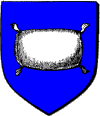 |
| Company of WOOL-PACKERS. |
Azure(some say gules), a wool-pack argent--The Company of WOOL-PACKERS, London.Word. See Letter.
Vert, a wool-pack corded argent--STAPLE'S INN, London.
Sable, a chevron between three packs or, cushions argent, tied of the first--Company of DYERS, London.
Azure, a wool-pack argent--JOHNSON.
Argent, a bend sable, on a chief of the second three wool-packs of the first--JOHNSON, Bp. of Gloucester, 1752; afterwards of Worcester, 1759-74.
Gules, three woolsacks argent[in chief a mullet or]--ASHLEY, London.
Gules, a chevron between three woolpacks argent--WOOLL, Rugby, co. Warwick.
Per saltire argent and gules, a lion rampant gardant or, on a chief wavy azure a wool-pack of the first between two bezants--BACK.
Argent, on a chevron between three woolsacks azure as many garbs or--WOLSAY, Norfolk.
Gules, on a fesse or voided of the field between three wool-packs argent three crescents gold--COOK, Blackheath, Kent.
Gules, a lion rampant or on a bend azure three wool-packs of the second within a bordure argent charged with eight cross of the field--DUNBAR, Scotland.
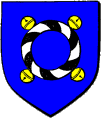 |
| JOCELYN. |
Azure, a circular wreath argent and sable, with four hawk's bells joined thereto in quadrature or--JOCELYN, Essex.Although the wreath proper is composed of one or more coloured stuffs, the Chaplets, q.v. of oak, laurel, and garlands of flowers, &c., are frequently blazoned as wreaths.
Gules, three lions rampant or with wreaths on their heads azure--KELLAM.
Azure, on a fesse between three garbs or a wreath of oak vert between two estoiles gules--Sandbach, co. Lancaster.
Ermine, a rose gules on a chief embattled or two banners in saltire, the staves enfiled by a wreath of laurel proper, a canton gules charged with a representation of a medal--NIGHTINGALL, co. Norfolk.
Pean, three mountain-cats passant in pale argent, on a canton or a fesse gules surmounted by an anchor of the third encircled by a wreath of laurel vert--KEATS, Dorrant House, Dover; quartering Goodwin.
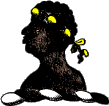 |
| Crest of MOORE. |
On a wreath argent and sable a moor's head in profile couped proper, wreathed or and of the second--Crest of MOORE or MORE.Wren: the Wren and the Robin Redbreast have been assumed as devices chiefly on account of the name. See also arms of ALDRIDGE, under Hawthorn.
Argent, a bend wreathed azure and or--OARE, Sussex.
Or, two bars wreathed bendy of eight azure and gules--JAKYS.
D'argent, à trois têtes de Maure de sable, tortillées du champ--RIGAUD, Auvergne.
Argent, a chevron sable between three wrens close sable(other wise brown, and in another case back vert and breast gules)--WRENBURY.Wrist-straps. See Strap.
Argent, on a chevron azure three wrens of the first, a chief gules charged with as many horse's heads erased purpure--WREN[the chief or, charged with as many heads erased brown--WRENNE, Harl. MS. 1404].
Argent, on a chevron between three wrens gules, as many mullets of the first--MANIGHAM.
Per pale argent and azure, a fesse nebuly counterchanged between three robin redbreasts proper--ROBYNS, Alderman of London.
Nebuly argent and azure, four birds(? robins) counterchanged--ROBYNS, co. Cornwall.